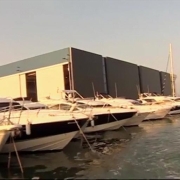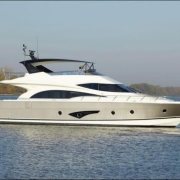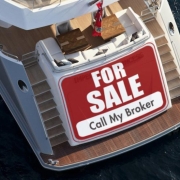CE Yacht Compliance Classification
29 March 2016


The CE Yacht Compliance Classification System is the European (CE stands for “Conformité Européenne” in French) dictating the standards for CE Certification for construction and sale of boats. Vessels in one of the categories of controlled products cannot be legally sold in the EU unless they have passed the tests to receive the CE Certification. This regulation applies to all yachts for sale and recreational craft from 2.5 to 24 meters, whether they are intended for navigation at sea or in inland waters. New or used boats coming from countries other than the Member States of the European Union are also subject to CE marking.
In 1994, the countries in the European Union adopted the Recreational Craft Directive (RCD), which they amended in 2003. This constitutes a single set of “harmonized” essential requirements for boats sold in any member country.
The compliance with the RCD is required by law in the European Union member countries, and third-party classification societies inspections and their certifications are required as part of the process of CE yacht compliance classification. Boats are given a CE certification at the end of the process, which confirms that they have passed and comply with the technical, construction, safety and legal requirements making them legally valid for sale in the European Union. In Europe, we call them commonly “CE compliant boats”.
CE certification required
Summary of the origin and CE yacht compliant classification and how certification works.
Since 1998, European legislation indicates that pleasure boats must carry the CE certification (or mark), requiring them to meet certain construction and safety standards. For this, the boats are classified into four categories according to their design and skills to face different sailing conditions depending on the wind force and wave height.
Knowing that the weather is a variable phenomenon, these categories are not intended to limit the distance boaters can sail away (this depends on onboard safety equipment), but rather to responsibly inform them about the capabilities of their boat to safely navigate based on the offshore weather conditions. For each vessel, the design category is characterized by a letter between A and D.
BEAUFORT scale
First, let’s start with the BEAUFORT scale. This scale gives you the status of the sea in order to plan your trips. It was the British admiral Francis BEAUFORT who imagined a scale with sufficiently precise criteria to quantify the wind at sea and allow the divulgation of reliable information universally understood. This scale consists of 13 degrees, from 0 to 12, which is remarkable in this scale is that it can assess the effect of wind on the surface of the sea.
We will focus on the scale with the forces of 6, 7 and 8 to our need for explanations. There is indeed a direct link between the Beaufort scale and the certification of yachts (see photo above of the scale to better understand the graduation of wind forces).
- CE CLASS A yachts are designed for large sea voyages (everywhere), in which wind force may exceed 8 on the scale of BEAUFORT and waves can also exceed a significant height of 4 meters. These yachts are designed largely to be self-sufficient in this rather hostile environment. CAREFUL, in most cases, this is only theoretical.
- CE CLASS B yachts are designed to travel off the coast (200 miles or less) in which the winds can be up to force 8 (not exceeding) and waves can reach a height up to 4 meters (not exceeding).
- CE CLASS C boats are designed for travel close to the coasts and in large bays, estuaries, lakes and rivers in which winds can be up to force 6 (not exceeding) and waves may reach a height of 2 meters (not exceeding).
- CE CLASS D boats are designed for cruises in protected waters, like small lakes, rivers and canals in which the winds can be up to force 4 and waves can reach a height up to 0.30 meter (less than 1 foot).
Rules of CE certification
The rules of CE certification for construction and sale of boats are designed to assess the structural strength and integrity of essential parts of the hull, the reliability, and function of propulsion, steering systems, power generation and all other features installed on board to help ensure the key essential services of the yacht.
You understand therefore that a CLASS A yacht respects a much more rigorous construction protocol than a CLASS B yacht and so on… Of course, it is strictly advised not to sail past a force 6 for pleasure yachting and no matter the class A or B. This is a matter of safety, comfort and pleasure being always present in your cruise.
To ensure recreational boating, always check the weather before each ride at sea and especially verify any potential changes every hour. In addition, you must always carry the safety equipment onboard depending on the type of navigation that you practice and the laws and regulations in the countries where you cruise, and feel free to be overcautious.
It is obvious that in case of bad weather, for example, it is better to find yourself onboard a CLASS A yacht, which will necessarily have a better safety margin, regardless of sea conditions… Before buying a new or pre-owned boat, always ask for the classification of your future yacht, this document is required for the new registration (in Europe).
A CE-Type Certificate (or homologation) is generally issued for production vessels manufactured in series by different shipyards, particularly European.
There are several classification societies capable of achieving the CE classification for construction and sale of boats, the main ones are RINA (Registro Italiano Navale), BV (Bureau Veritas), DNV (Det Norske Veritas), Germanischer Lloyd, LR (Lloyd’s Register).
Other societies and certifications
There are also other classification societies for vessels built or sold outside the EU such as ABS (American Bureau of Shipping) and NK (Nippon Kaiji). There are also other types of certifications such as the MCA (UK – Maritime and Coastguard Agency), which however is not a classification organization. We will write more articles on commercial classifications later.
Do not hesitate to contact us for any need for further information on the CE yacht compliance classification, our team at Allied Yachting is at your service.











